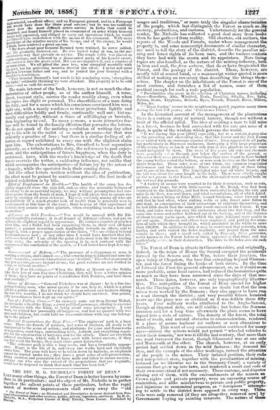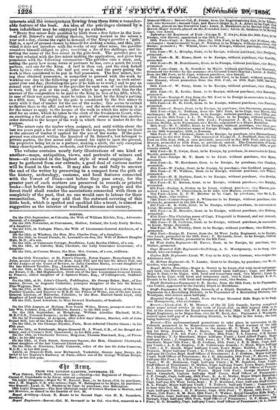THE REV. H. G. NICHOLLS'S FOREST OF DEAR'.*
LIRE many other things, the Forest of Dean is better known byname than in its particulars ; and the object of Mr. Nicholls is to gather together the salient points of these particulars, before the rapid march of modern improvements shall sweep away the " old
" The Forest of Dean; an Historical and Descriptive Account derived from Per- t?ttalObservation and other sources, public, private, legendary, and local. Hyll. G. ylis: M.A., Perpetual'Curate of Holy Trinity, Dean Forest. Published by
• V • ••••••
usages and traditions," or more truly the singular ohme, of the people, which. last distinguish the Purist as munh as/ scenery, productions, and qustome., Unfortunately for the gen reader, Mr,. Nicholls has collioted a.good deal more from books than he has gathered fronireality. Old charters, old authors, the reports of the Woods and Forests, under whose management the property is, and some manuscript documents'of similar character, are used to tell the story of the district, descrihe the peculiar mi- ning and forest rights of. its born, Men, and the,vanous contests they have had with the crown and its appointees. More living topics are also handled, as the nature of the mining industry, both in iron and coal, the fern nat arm, that do or have frequented. the Forest, and the geology of the district. These, however, are mostly told at seoond hand, or a manuscript writer quoted is more skilled at making an inventory than describing the things thenta. selves. The chapter on the inhabitants of the Forest is oiled the most curious, and furnishes a list of names, some of thent poetical enough for Such a nab population. , If Peculiarities also occur in the selection of Christian names, inoluding. these—Benedicta, Abia, Winifred, Kezia, llarzillai, Si'oylla _ Eve, Saba,. Sabina, Beata, Tryphena, Belinda, Myra, Terzah,
Miles &e. .
River Jordan' occurs in the neighbouring parish registers many times during. the List 1:30 .years ; also ` Providence Potter.' " In the historical account of the management of the plantations- there is a curious story of natural history, though not withoutas trait of the official mind. The idea of sending a an to kill mien in a forest, because he had succeeded with the rats and mice of a fleet, is quite of the wisdom which governs the world. " It was dining this year [1814] especially, but to a certain degree else in the preceding and succeeding ones, that this Forest and the New Forest were visited with an enormous number of mice. They appeared in all parts; but particularly in Haywood enclosure, destroying a very large proportion of the young trees, so much so that only four or five plants to an Here were found uninjured by them. The. routs of five years old oaks and chesnuts were generally eaten through just below the surface of the ground; or wherever their rues Proceeded. Sometimes they were fdund to have barked the young hollies round the bottom, or were seen feeding on the bark of that upper branches. These mice were of two kinds, the common longtailed field-mouse and the short-tailed. There were about fifty of these latter sort to one of the former. The long-tailed mice had all white breasts, and the tail was about the same length as the body. These were chiefly caught on the wet greens in the Forest, and the short-tailed were caught both on the wet and dry grounds. "A variety of means were resorted to for their destruction, such as cats, poisons, and traps, but with little success. A Mr. Broad, who had been employed by the Admiralty, and had been successful in killing the rats and mice in the fleet, was sent down, and tried several plans, all of which failed: At last, a miner living on Edge Hills, named Simmons, came forward and said that he had often, when sinking wells or pits, found mice fallen 'fri- end dead, in consequence of their endeavours to extricate themselves, and he had little doubt that the same plan would succeed in the Forest. It was tried, and holes were dug over the enclosures about two feet deep, and the same size across and rather hollowed out at the bottom, and at the distance of about twenty yards apart, into which the mice fell,land were unable to get out again. Simmons and others were employed, and paid by the num-, bers of tails which they brought in, which amounted in the whole to more than 100,000. In addition to this it may be mentioned that polecats, kites, hawks, and owls visited the holes regularly, and preyed upon the mice caught in them ; and a small owl, called by Peumult, Stri.c passcriftl,' never known in the Forest before or since, appeared at that time, and Wen particularly active in their destruction. The mice in the holes also ate each_ other."
The Forest of Dean is situate in Gloucestershire, and originally,,, indeed, in the reign of Henry the Second occupied the peninsula formed by the Severn and the Wye, before their junction, the apex being at Chepstow, the base line extending beyond Glestee67 ter, and the forest lining the banks of both rivers. By the time, of Edward the First the general advancement, or, as it would seem: more probable, some local causes, had reduced the boundaries quite, as much as they have been narrowed since the days of that mo- narch. These dates, however, aro only topographically illustraa five. The antiquities of the Forest of Dean ascend far higher. than the Plantagenets. There seems no doubt but that the in mines were worked by the Romans ; they also appear to have run, a road through the district ; and very possibly fifteen hundred: years ago the place was as civilized as it was within these fifty years. Four military works attributed to the Anglo-Salons, though of disputed date, are still visible; but before the Norman invasion and-for a long time afterwards the place seems to har: lapsed into a'state of nature. The density of the forest, the
want of roada, and natural obstacles to communication, rend
it a place of secure harbour for outlaws or men 'obnoxious to' authority. This want of easy communication continued for many ages—indeed the miners would not permit " wheeled vehicles to, enter their domain," " nor was it till the,last century, that more than one road traversed the forest, though Gloucester was at one side' and Monmouth at the other. The ohurch, however, at an early, period had settled down in the wild fastness ; the demand...for iron, and the example of the older workings, turned the attention- of the people to the mines. Their isolated position, their rue. and independent state, together with the peculiarities of mining,: induced (as we likewise see in the Stannary Court) a variety of customs that grew up into laws, and rendered a court and code of their own convenient if not necessary. These customs, and disputes arising out of them, with the encroachments of the miners en Crown rights and, private property, were an unceasing source OP contention, and 'alike .mischievous to private and public property,. and injurious to economical progress, as " foreigners " attempt-.- ing to settle in the district were opposed in every way. The evils were.only removed (if they are altogether removed nowlity. • Government buying up existing interests. 'the nature of ablem4416160 tiotvittfrbtAdhiffciliiiitidonsider ate featuretef the hoek. An idea ef the Vtavileges claimed by a barn inhaltiant'Mayehe 041reyed by an exteact. "Every free miner .duly.qualified by birth from afree father in the huti- drectof St—El-Wars 'and. abidiiit therein, having worked in the minesw year and a day,.elaireathe,nglit to demand' of the King's.gaveller a thAis, a spot of ground chosercby himself for sinking a nune,,and thisy pro- vided it does not—interfere with:the works ' of any *ermine, •the gavoller considers himself to give, receiving a fee &__five shillings, and in- serting the name of the free miner in the gale-book. The gaveller goes to the spot selected with thelree miner making the application, and gives him possession with the 'following cerenienieille gaveller en& stick, ands asking the party how many verns or partners he has, cuts a notch for`eviry partner, and one for the. Xing. A turf is then cut, and the stick 'forked doWn by two other sticks, the turf put over it, and the party galing the work is then considered to be put in full possession. The free 'rimer, hav- ing thus obtained possession, is Compelled to proceed with the work by working one day in the following year and day, and a day in each subse- quent year and day, (forfeiting the gale if he fails so to work,) and to pay. an annual sum of two guineas to the .gaveller for each vein of coal he intends to work, till he gets at the coal, after Which he agrees with him for the amount of the composition to be paid to the King in lieu of his fifth, which, in case of their not agreeing, must be taken in kind by the King's putting in a fifth man. The light to the gale is considered by the free miner to carry with it that of timber for the use of the works ; this seems to extend no farther than to the offal and soft wood; and the mode of obtaining Wig for the miner to apply to the keeper of the walk in which his mine is situ- ated for an order, which he takes to the clerk of the Swainmote Court, who, on receiving a fee of one shilling, as a matter of course gives him another order directed to the keeper of the walk in -which there is timber fit for the p • • "The miner cuts the timber when assigned, and until within about the last ten years paid a fee of two shillings to the keeper, there being no limit to the amount of timber if applied for the use of the works. If the gale- ground was situated within the hundred of St. Morel's, but belonged to private parties, the free miner still claimed his right to open the ground, the'proprietor being let in as a partner, making a sixth, the only exception being churchyards, gardens, orchards, and Crown plantations."
The volume contains nearly forty illustrations of one kind or smother—maps, antiquities, views, and portraits of miners and trees—all executed in the highest style of wood engraving. As may be gathered from our extracts, a good deal of curious matter will be found in the work. It may also be said fully to answer the end of the writer by preserving in a compact form the pith of the history, archaeology, customs, and local features connected with the Forest of Dean—not before they pass away, for the greater part of such matters are preserved in records or printed books—but before the impending change in the people and the forest itself shall render the associations connected with them so completely of the past, that no one would care to labour for their resuscitation. We may add that the outward covering of this little book, which is spotted and speckled like a trout, is almost as suggestive as the interior of woodland streams and scenery.



























 Previous page
Previous page